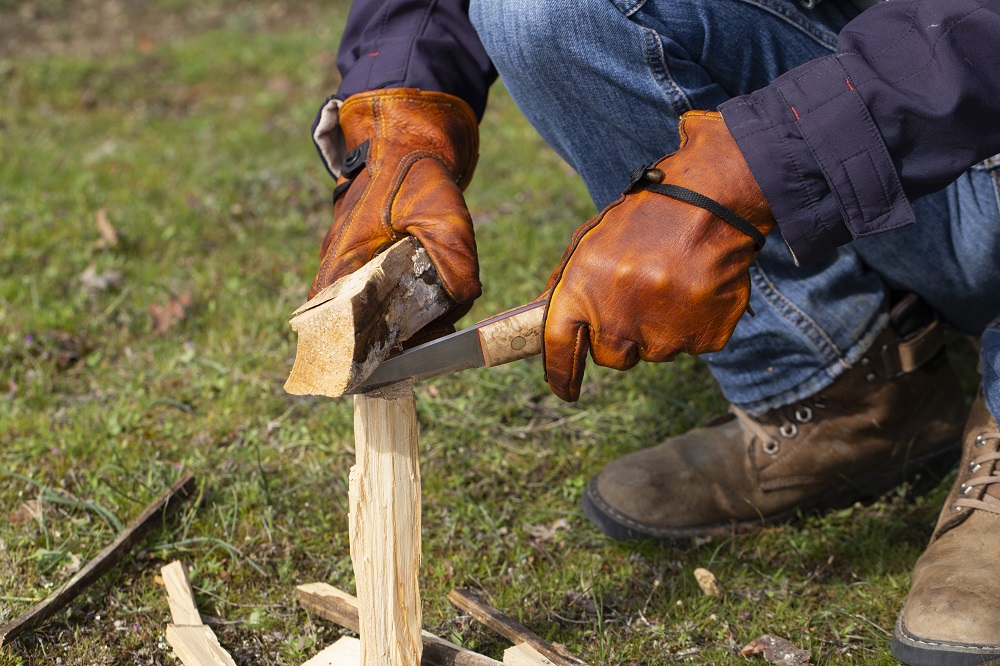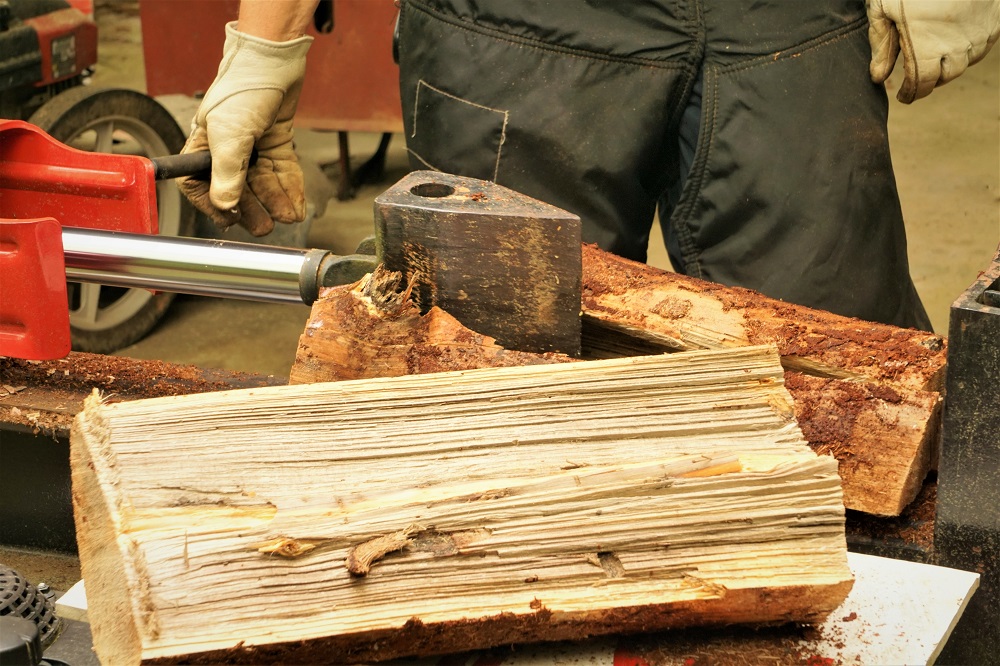
When you’re camping out, building a nice fire can keep you warm all night long, can repel predators, and allows you to cook food and boil water. But what if you don’t have an ax? Learning how to split logs without an ax is possible, using some other types of powerful tools in its place. However, if you’re in need of an axe when you’re camping out, you may have to make do with what you have on hand.
Batoning
Batoning is a type of bushcraft technique that involves the use of a knife to split wood. The knife is positioned on the wood, then hit repeatedly using a blunt object, such as another piece of wood. This is a good technique to use if you’re camping and you forgot your axe, or the axe you brought along is unusable.
Batoning is a common technique used to create kindling or split logs. This technique can also be used to give you access to the dry inner portion of a wet log.
Many outdoor enthusiasts believe that this technique is easier than chopping wood with an axe since it doesn’t require as much physical effort, and in some cases, it can be much faster. It also doesn’t require as much experience as chopping with an axe, since as a beginner, when you first chop wood your aim will not be the best. Batoning is the perfect technique to use when you don’t have an axe around and you need to prepare firewood in a hurry.
But in certain weather conditions, or if you’re dealing with mainly wet logs, using this technique can be difficult. Additionally, you can end up breaking or damaging your knife. In order to reduce the chances of breaking the knife always use the proper batoning technique.
A knife can break when using this technique because of the angle that’s being used. If it’s placed in a straight position during the process then the knife will be less likely to break. Using this technique with the wrong type of baton can also cause a knife to break, or it can cause significant damage to the knife. Because of this, many experienced outdoorsmen recommend only using wood for this technique. If the right technique is used, then your knife will survive unscathed.
The Right Technique
Use a piece of wood for batoning. It’s definitely the best tool for the job. Avoid using rocks or bricks since they can be very difficult to work with and can end up damaging the knife’s spine. The best type of wood to use is hardwood. If you have a lot of wood to slice through, then you can shape a piece of wood so that it’s similar to that of a short baseball bat. You’ll need to thin out the handle portion, then sand it down for a smoother grip. The goal here is to use a comfortable baton with a wider hitting surface.
The Best Knife for the Job
You can use this technique with any type of fixed blade knife, just as long as the blade is strong and can handle repeated use. A knife that has a full tang will be stronger, so it will be a better choice for batoning and will be less likely to break.
The size of the knife you choose will depend on how wide the wood is. The edge of the blade should be around three inches longer than the diameter of the wood. If you’re looking for a more versatile knife to use then go with one that has a longer blade.
How thick the blade of the knife is won’t make as much difference as the blade’s length. However, the job will be easier if you use a knife with a thicker blade.
In terms of the knife’s handle, if the handle is very rigid it can create vibrations that are uncomfortable when it’s hit with the baton. Choose a knife that has a handle that’s completely encased in some type of synthetic material, which can help to significantly reduce vibrations.
As you can see, once you get the hang of the process, batoning can be very effective at splitting logs, however, if you don’t have the right type of knife, the process can be difficult and uncomfortable if you have a lot of logs to split.
The Splitting Wedge

Building a fire will be your top priority when you’re camping out. If you’re camping for a night or two, then you can make do with some small branches and kindling sticks, however, they will probably burn out too quickly and will not be able to keep your fire going all night. You’ll need to break down some larger pieces of wood sooner or later.
However, if you’re left without an axe then the process can be tricky to say the least. As I mentioned above, if you’re dealing with small logs then you can try using a fixed blade knife and some hardwood in order to baton the wood down to the right size. For logs that are much wider than the length of your knife you won’t have a chance of getting the job done, so you’ll need to resort to the wedge technique.
Hardwood Use
This technique is similar to batoning. However, instead of hammering a knife through the length of the wood you will construct hardwood wedges. Keep in mind that you need to work only with hardwood since softwood tends to crack or buckle the minute you begin to pound into a log.
Using a splitting wedge is a great alternative to using an axe, especially if you need to split a high volume of wood. The wedge is triangular in shape and it’s used to drive into medium to large logs with the help of a wooden mallet or sledgehammer. Many people who split logs for firewood feel that a wedge offers more of an advantage over using an axe.
Most newer models are made out of heavy-duty forged steel, which allows the user to easily tap the edge into a log for fast and efficient cutting and splitting.
A splitting wedge is typically used to split a large block of wood, but they’re actually very efficient at cutting up logs for firewood.
This tool is very beginner friendly. All you have to do is place the wedge into a crack in the wood. If the log doesn’t have a crack in it, you can drive the wedge into the wood using the back of a maul or a hammer.
Using this device for several hours can be very hard on the body, just like using an axe can be, but many outdoorsmen claim it’s more efficient than an axe and its highly portable design will allow you to stow it in your camping gear.
It will also come in handy if you’re at home and your axe becomes damaged and needs to be replaced.
Wedge Techniques
You can use a straight solid blow to hammer a wedge into the wood until it splits. If you’re not able to get the wedge all the way through and the wood refuses to split, use the wedge on another spot along the same crack. However, you should try using it closer to the edge of the wood.
A splitting wedge will work the best when it comes to large diameter blocks or knotty pieces of wood.
It can be much easier to use compared to an axe or a maul. With a wedge, you’ll have better leverage. Using an axe places too much strain on the arms. With a maul, it will take more energy and time to split wood since it’s much duller.
In many instances, the wedge can also deliver better results when it comes to cutting hardwood logs down to size. Basically, the wedge is one of the best tools you can use to cut and split logs with. They provide better accuracy compared to an axe and they don’t require nearly as much energy to use.
Gas Log Splitter

Using a log splitter is another option. However, it’s a rather heavy-duty piece of equipment. This monster can easily tear through the thickest logs. If you’re physically unable to split logs using an axe, then this fairly hands-off machine is your best bet. However, a log splitter is an expensive piece of machinery. So, unless you have a high volume of wood to go through, then a log splitter may not be the best alternative.
Electric Log Splitter
If you’re on a tight budget, then an electric log splitter can be the best option. This type of log splitter is not as powerful as its gas-powered counterpart, but it’s the perfect choice for the homeowner who’s on a tight budget and looking for an easier way to split firewood.
These log splitters will cost a few hundred dollars, compared to a gas-powered model that can cost thousands of dollars. Log splitters are rated in measurements of tons of pressure applied. The higher the tonnage, the bigger the log you’re able to split. Gas models often have a rating of over twenty tons. However, if you don’t have to split several logs every winter, then you can easily get by with a model that has a six- or seven-ton rating. Some models can split logs that are over ten-inches thick. Because of this, it’s a good idea to purchase a high-quality electric splitter so that you’re able to split large logs and you won’t be limited concerning what you can use for firewood. Avoid purchasing a cheap model that won’t give you the versatility you need to cut up fallen trees or free logs that come your way. You need an electric model that’s powerful and versatile.
Table Saw
If you don’t have a log splitter, then try putting your table saw to work. Using your old table saw can make the whole log splitting business much easier. This is especially true if you have a big wood pile and you don’t have access to a maul or axe. With a table saw, you’ll want to rip the log in a few different places. Once the log has been split in a few spots then you can use the hammer and wedge and use the method I discussed earlier. By partially splitting the log using the table saw, you’ll come close to reaching the center of the log, so when the wedge is used, splitting the log entirely in half is that much easier. All the wedge needs to do is push past the center of the log and the job is done. It’s a great way to streamline the entire process, if you’re left without an axe.
Final Thoughts
While using an axe is definitely a more convenient way to go about splitting wood, learning how to split logs without an axe is totally possible, but in some cases, it can make for a lengthier process. However, if you have a table saw, wedge, know how to baton, or you have a log splitter, then once you find your rhythm, you can easily make short work of your wood pile and get the job done in a fraction of the time.
source https://woodcutterhq.com/how-to-split-logs-without-an-axe/
No comments:
Post a Comment